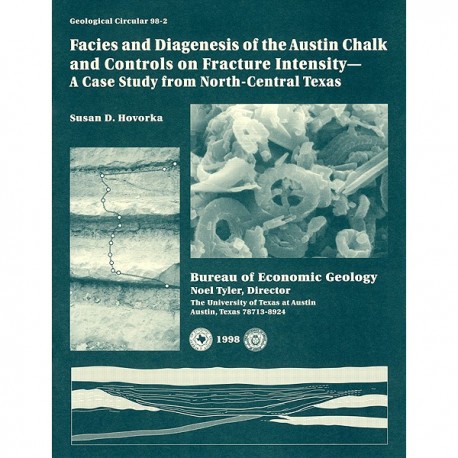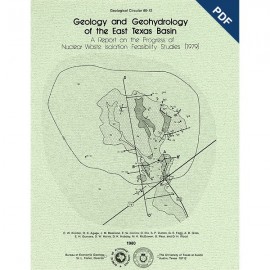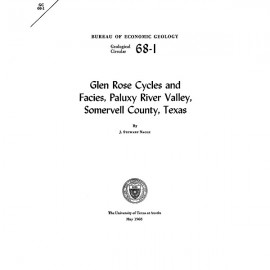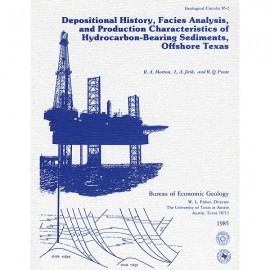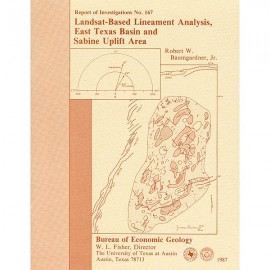Geological Circulars
-
Books & Reports
- Reports of Investigations
- Guidebooks
- Udden Series
- Geological Circulars
- Down To Earth
- Atlases of Major Oil and Gas Reservoirs
- Texas Memorial Museum Publications
- Environmental Geologic Atlas of the Texas Coastal Zone
- Mineral Resource Circulars
- Other Reports
- Seminars and Workshops
- Handbooks
- Submerged Lands of Texas
- Symposia
- Annual Reports
- Open File Reports
-
Maps & Cross Sections
- Thematic Maps
- Miscellaneous Maps, Charts & Sections
- Geologic Atlas of Texas
- STATEMAP Project Maps
- Geologic Quadrangle Maps
- Cross Sections
- Highway Geology Map
- Energy and Mineral Resource Maps
- Shoreline Change and Other Posters
- Wilcox Group, East Texas, Geological / Hydrological Folios
- Bouguer Gravity Atlas of Texas
- River Basin Regional Studies
- Featured Maps
- Posters
- Teachers & the Public
-
Geological Society Publications
- Gulf Coast Association of Geological Societies
- Alabama Geological Society
- Austin Geological Society
- Corpus Christi Geological Society
- Houston Geological Society
- Lafayette Geological Society
- Mississippi Geological Society
- New Orleans Geological Society
- South Texas Geological Society
- GCS SEPM Publications
- Historic BEG & UT Series
Facies and Diagenesis of the Austin Chalk and Controls on Fracture Intensity-A Case Study from North-Central Texas
GC9802
For a downloadable, digital version: GC9802D.
GC9802. Facies and Diagenesis of the Austin Chalk and Controls on Fracture Intensity--A Case Study from North-Central Texas, by S. D. Hovorka. 47 p., 34 figs., 6 tables, 1998. ISSN: 0082-3309: Print.
To purchase this publication as a PDF download, please order GC9802D.
About This Publication
Using geologic and engineering data, the author documented Austin Chalk depositional environments and diagenetic alterations and investigated the factors that have influenced fracture development. Research was funded by the Texas National Research Laboratory.
ABSTRACT
The urban corridors associated with the Dallas, Austin, and San Antonio metropolitan areas lie on Austin Chalk outcrop. In these areas of rapid urbanization, ground-water information is needed to resolve environmental issues. The Austin Chalk also produces hydrocarbons in the deep subsurface. Fluid migration in both oil-field and ground-water environments is strongly controlled by fractures. In each geologic setting, a conceptual model of fracture intensity is required to model or predict flow. Using geologic and engineering data collected during development of the U.S. Department of Energy's Superconducting Super Collider (SSC) in Ellis County, Texas, I document Austin Chalk depositional environments and diagenetic alterations and investigate the factors that have influenced fracture development. Key findings are: (1) the Austin Chalk is laterally and vertically relatively homogeneous, reflecting deposition in deep water on high-productivity, flooded, continental shelves during Late Cretaceous worldwide sea-level highstand; (2) although rhythmically interbedded chalk and marl record intermediate-frequency sedimentological variability, no lower-order cyclic patterns could be identified; (3) facies within the Austin Chalk defined by variations in character of the cycles record marine flooding, deepening, and shallowing; (4) sedimentary structures in excellent exposures in SSC excavations and tunnels provide evidence of sediment transport through channels during Austin Chalk deposition; (5) fracture intensity is low in the middle Austin Chalk as compared with that in the upper and lower Austin Chalk; and (6) ductility, porosity, and permeability are genetically linked to chalk microfabrics. These properties are controlled, not by depositional facies, but by diagenetic alteration of minor amounts of volcanic ash co-deposited with chalk.
Keywords: Austin Chalk, Ellis County, facies, fractures, stratigraphy, SSC, Superconducting Super Collider, Texas
CONTENTS
ABSTRACT
INTRODUCTION
Scope and Purpose
Regional Setting of Austin Chalk Deposition
Faulting and Fracturing in the Austin Chalk
Methods
STRATIGRAPHIC VARIATION IN THE AUSTIN CHALK
Stratigraphic Units
Eagle Ford Formation
Lower Austin Chalk
Middle Austin Chalk
Upper Austin Chalk
Ozan Formation
Stratigraphic Distribution of Fractures
Patterns of Chalk-Marl Cycles
Petrographic Description
Chalk
Marl
Porosity and Permeability
Insoluble Residue
Clay Composition
Sand-Sized Material
Total Organic Carbon
Stable Isotopes
STRATIGRAPHIC RELATIONSHIPS AND ROCK PROPERTIES
Microfabric Control on Rock Properties
Sources of Volcanic Ash
Chalk-Marl Cyclicity
Diagenesis
Vertical Facies Variation in the Austin Chalk
CONCLUSIONS
ACKNOWLEDGMENTS
REFERENCES
Figures
1. Location of the Austin Chalk outcrop; major hydrocarbon-producing fields: Balcones, Luling, Mexia, and Talco fault zones; and the Ellis County study area
2. Sedimentation on the Texas shelf and its relationship to sea-level curves
3. Upper Cretaceous paleogeography
4. Generalized geologic map of part of Ellis County in north Texas, outline of SSC project area, location of boreholes used for stratigraphic and hydrogeologic data and outcrop locations
5. Composite section of Austin Chalk
6. Commercial wireline log showing typical SP log character of the Austin Chalk in Ellis County
7. Characteristic lithologies of unit T
8. Characteristic lithologies of unit A
9. Unit A channels, well exposed in the SSC tunnel
10. Southwest-northeast cross section, showing representative gamma-ray-log stratigraphic correlations of units A, B, C, and D along strike, northwest part of the SSC ring
11. Characteristic lithologies of units B and D
12. Characteristic lithologies of units E through I
13. Characteristic lithologies of units K and L
14. Stratigraphic subdivision of Austin Chalk. Ellis County, Texas, and regional fracture intensity of individual chalk units
15. Characteristics of chalk-marl cycles observed in outcrop and core
16. Plot showing cycles defined by percent insoluble residue and total organic carbon
17. Average chalk- and marl-bed thickness of grouped informal subsurface units
18. Petrography of typical chalk
19. Typical SEM views of chalk
20. Photographs of microstructures in typical chalk
21. SEM photographs of clay coats obscuring details of nannoplankton tests and filling pores in most chalk samples from the middle Austin Chalk
22. Petrography of typical marl
23. Trend with depth in porosity and permeability
24. Graph showing relationship between porosity and permeability
25. Vertical distribution of acid-insoluble material in chalk and marl
26. Average percent clay-sized material in chalk and marl
27. XRD charts showing clay composition of representative samples of acid-insoluble residues from several stratigraphic intervals
28. Vertical distribution of percent of sand-sized materials from acid-insoluble residue
29. Photomicrographs of sand-size materials from acid-insoluble residues
30. Vertical distribution of δ18O and δ13C in calcite through the Austin Chalk
31. Graph showing relationship between δ13C and δ18O in chalk and marl samples
32. Microdistribution of clay, drawn on the basis of SEM examination of typical samples from various Austin Chalk units
33. Graph showing relationship between chalk permeability and δ18O of calcite and δ13C of calcite, both showing a weak negative correlation
34. Block diagrams showing regional paleogeographic reconstruction of the Austin Chalk
Tables
1. Literature on stratigraphy and biozonation of the Austin Chalk
2. Dominant lithologies within the Austin Chalk
3. Characteristics of Austin Chalk facies
4. Petrologic characteristics of informal Austin Chalk units
5. Porosity and permeability data from analysis of core plugs
6. Stable isotopes from representative chalk and marl in the Austin Chalk
Citation
Hovorka, S. D., 1998, Facies and Diagenesis of the Austin Chalk and Controls on Fracture Intensity--A Case Study from North-Central Texas: The University of Texas at Austin, Bureau of Economic Geology, Geological Circular 98-2, 47 p.
